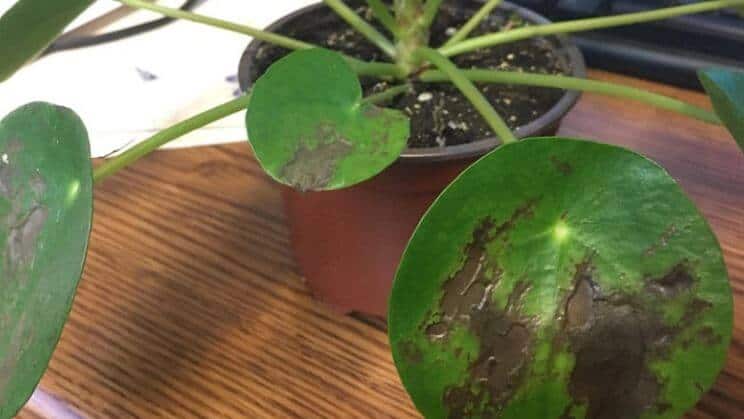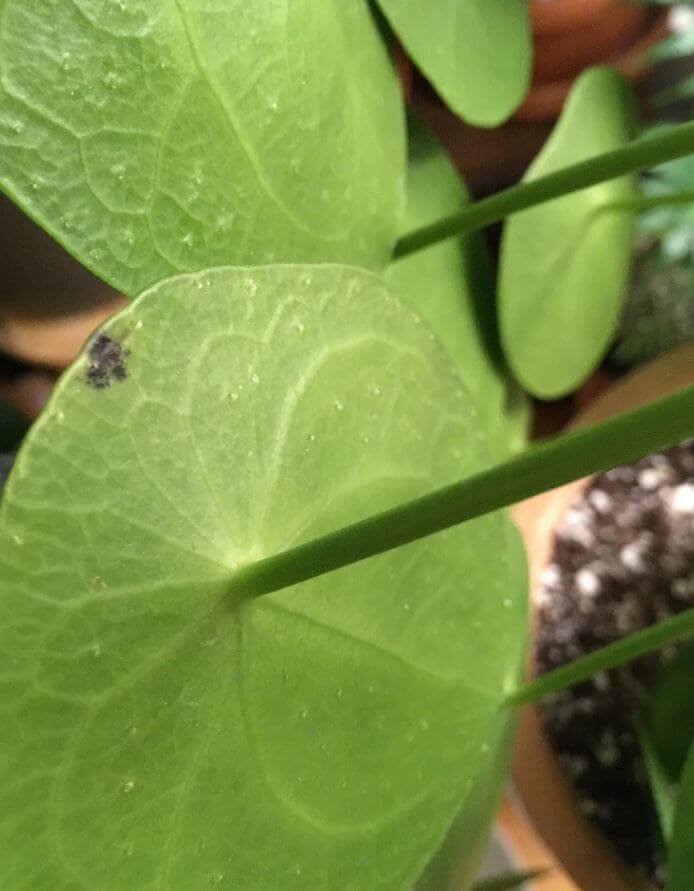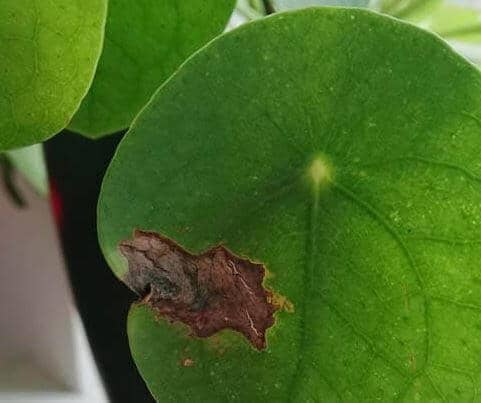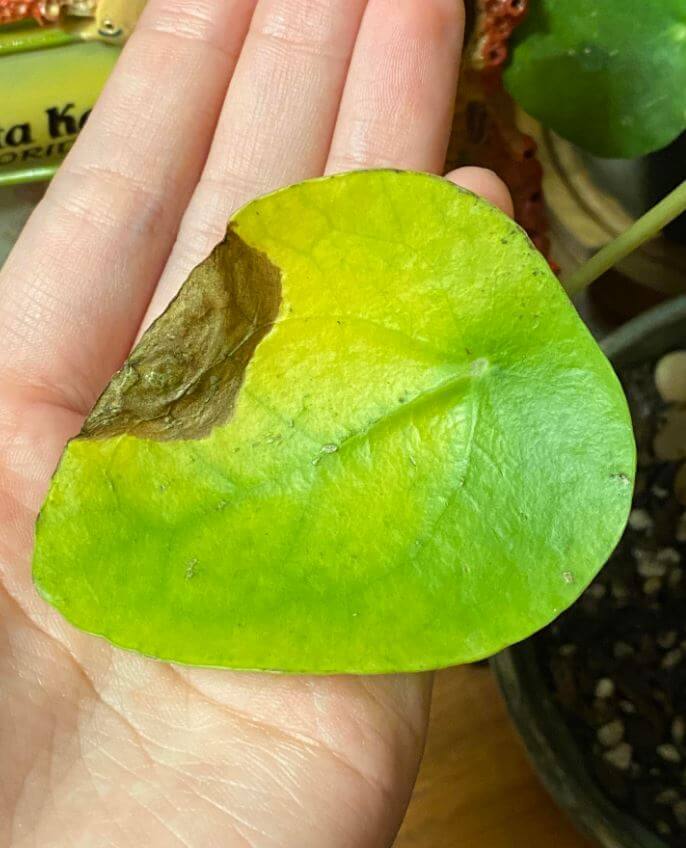Last Updated on June 29, 2023 by a Friendly Gardener
The evergreen perennial Pilea peperomioides is a native of southern China. This delightful plant boasts deep green, round, leaves that can grow to an impressive four inches in diameter. Popularly known as the Chinese Money Plant and considered a bearer of good fortune, the pilea has an erect growth habit that can reach approximately a foot in height and width in its native habitat. Indoors it can grow even taller.
Uniquely beautiful, these plants are popular choices as houseplants. Nonetheless, Pileas are subject to infections that may appear in the form of spots in a variety of colors. These are symptoms of a serious issue regarding the environment where the plant is located or with the care routine.
What Are the Causes of Black Spots on Chinese Money Plants?

Chinese Money plant black spots can be worrisome for Pilea owners, but to treat spots, it’s vital to identify the cause. Typical car issues that cause spotting include overwatering and soggy soil. Insufficient light, and pest infestations. Let’s consider some specifics.
Edema
Chinese Money Plant black spots on leaves are often caused by edema disease. Spots may be white as well as black and appear on foliage due to overwatering and insufficient light. The initial symptoms will be white spots that when left unattended, will turn yellow and eventually black. When spots are black the leaf tissue has already become necrotic and is dying.
Overwatering causes soggy soil, so the plant’s root system will send excessive water throughout the plant. Plant pores clog causing scabs and white spots.
What to Do
Interrupt watering your plant immediately. Move the plant to a spot with generous amounts of bright indirect sunlight but avoid direct sunlight as this can sunburn leaves. Allow excess water to drain if possible or consider repotting your plant in fresh soil.
Limit watering to once or twice weekly when the top inch or so of the soil bed is dry. Do not place Chinese money Plants in trays of water as this can lead to waterlogged soil.
Watering: Too Little or Too Much

This is probably the most common mistake plant parents make and the cause of Chinese Money plant black spots.
What to Do
Use both a pot and potting soil with good drainage. Water when the topsoil is dry at least an inch deep and until excess water drains from the pot’s drainage holes. Do not wet the leaves. Reduce watering during winter months and use collected rainwater or distilled water if possible.
Fungi Spores and Bacteria

Large black spots or patches may cover stems, leaves, and even the roots of Pileas. They may also initially appear as a type of white or yellow film covering a few leaves. However, when ignored these symptoms quickly spread to many leaves and eventually to the entire plant. This happens when airborne fungal spores or bacteria land on plant leaves and begin to attack leaf tissue. These infections will cause leaves to discolor, wilt, and die.
Many fungal infections will cause leaves to develop black spots and begin to die. The saprophytic fungus also known as white mold, will completely cover foliage. Death will not be immediate, but it will infect the entire plant rapidly and spread to other houseplants.
What to Do
If the plant only shows a filmy covering, wipe the affected leaves clean using a damp cloth. Trim off all severely damaged foliage and isolate your Pilea from other houseplants you may e cultivating. Place your plant in a location with great air ventilation and generous amounts of bright, indirect sunlight. This will aid in drying excess moisture that creates the ideal conditions for fungi and bacteria to multiply.
Improper Light
Light is an essential factor for the survival of any plant. They require it for photosynthesis and nourishment, as well as development and growth. Still, the Chinese Money Plant prefers indirect sunlight. When exposed to direct sunlight for too much time, the plant will suffer sunburn of its leaves. These burns will then turn black, wilt, curl, and die.
What to Do
If you have left your Pilea in the sun for too long, begin by moving it to a cooler location and away from any direct sunlight exposure. You may want to place it in the shade for several days until you notice new growth, after which you can move it into indirect light.
Extreme Environmental Temperatures

The ideal environmental temperature for a Chinese Money plant should be in the range of 60° to 80°F. Often, heat trauma will manifest itself with black spots appearing on foliage, or leaves may wilt and curl. These plant reactions will also appear if temps are too cold. Extreme temperatures cause leaf tissue to break down.
Frost can kill a Pilea, so do not place this plant outside or near drafty windows and doors if you have a harsh winter season. Black soggy spots indicate excessive cold.
What to Do
Place your Pilea in a room with a temperature measuring between 60° and 80° F. If you have doubts, measure the room temperature, and move your plant to a more suitable environment if necessary. In the winter, spots near heat sources can aid your plant in resisting temperature drops, while they will need a well-ventilated cool spot in the summer.
Pest Infestations
Chinese Money plants may also develop black spots from pest infestations and attacks because the plant cuticle will thin out. Aphids and thrips are particularly problematic for pileas as they are sap suckers. They will suck the life right out of the plant by stealing its nourishment. Big black round spots on leaves are often indicative of a pest infestation. Check your pilea before bringing it home from a garden center or nursery and isolate your new pilea so that any pests present will not migrate to your other houseplants.
What to Do
Clean foliage regularly with a damp cloth. Apply neem oil or insecticidal soap to your pilea. Remove all infested and damaged leaves.
Overfeeding

The excessive fertilization of a Pilea can cause spots to appear on stems and leaves. Salts in fertilizers as well as those found in municipal tap water can clog plant stomata or pores.
What to Do
Use a diluted liquid fertilizer for foliage plants. Only fertilize your Pilea once monthly from the late spring to the middle of the fall. In winter, do not fertilize as your Pilea will enter dormancy. Avoid using tap water for watering. Use collected rainwater or filtered water instead.

